Gas Engines
-
- New Era for Gas Engines Maritime Reporter, Jun 2004 #42
With more than 300 lean-burn, spark-ignited gas engines supplied for stationary power applications over the past 15 years, Rolls-Royce is making a determined bid to break into the marine propulsion market with its newly-bolstered series of Norwegian-developed, gas-fueled Bergen engines. The preparation of the K-G4 type for shipboard use, plus the unveiling of the altogether more potent B35:40V-G design, have been driven by mounting environmental legislation and by national commitments to air pollution reduction attendant to the Kyoto Protocol.
While cognizant of the longer-term, international market scope, the business rationale in developing a marine offering of environmentally-friendly reciprocating prime movers, conceived for 100-percent operation on gas, has an immediate national relevance, given the opportunities presented by Norway's investment in its LNG fuel supply infrastructure. A government- inspired project for five gas-fuelled, doubleended road ferries to serve two of the country's longer fjord crossings is expected to provide an important platform for the technology, and the gradual extension of LNG bunkering points along the sea rim, coupled with a circumspect national energy policy, is expected to stimulate the uptake of gas-fuelled power and propulsion plant in coastal and offshore vessels. A small Norwegian LNG tanker and a modern tjord ferry currently use LNG as fuel in their high-speed engine plant, while two sophisticated offshore support vessels working Norwegian fields are distinguished by dual-fuel, medium-speed prime movers. The planned adoption of dual-fuel plant in French LNG carrier newbuilds has provided a fillip to the advocates of that technology. However, Rolls-Royce contends that its medium-speed, purely gasingesting machinery provides a simple, highly effective solution to low-emission powering needs, lending itself both to direct mechanical coupling to propellers and thrusters, and to shipboard electricity production. Moreover, test results have demonstrated that there are no operational limitations on sustained low load or transient operations.
Among the claimed advantages of employing lean-burn, gas-fuelled. Otto cycle engine technology are the low level of Nox (oxides of nitrogen) emission and the negligible release of Sox (oxides of sulfur) and particulates. LNG as a fuel has the attraction that its carbon content is lower than other hydrocarbon fuels such as diesel oil. If it is efficiently burned, the C02 (carbon dioxide) emissions from the engine are correspondingly low, a very positive factor for countries that have signed up to the Kyoto Agreement, and salient also to anticipated future international edicts governing C02 from ships' machinery.
An added economic benefit is that lube oil consumption is low, and oil change intervals are long.
The main frame and much of the running gear of the K-gas engine is derived from the successful Bergen K-series diesel engines used in hundreds of vessels.
A power output of 220-kW per cylinder is available, with running speeds between 600- and 1,000-rpm.
The K-G4 has been released in configurations of 6, 8 and 9 in-line cylinders, and in 12-. 16- and 18-cylinder veeform, covering unit powers to approximately 4,000-kW. If required at some later stage, K-gas engines can be converted for operation on marine diesel oil, and the company has also declared its readiness to convert K diesel engines to burn gas. A much larger, lean-burn, spark-ignition engine, founded on the B32:40 diesel engine hardware and Kgas engine technology, has been launched for unit power needs up to 8,800-kW. Offering 440-kW per cylinder, in vee-type models of 12, 16 and 20 cylinders, the B35:40V-G design is said to have a thermal efficiency of 47-percent.
Although the B-gas engine has been primarily conceived for the expanding market for reciprocating engines for stationary, industrial uses, the 350 mm-bore design offers scope as a marine power unit. In its 20-cylinder layout, the new Norwegian-built offering is claimed to be the world's most powerful spark-ignited, reciprocating gas engine.
-
- Caterpillar for Vessel Driving Power Maritime Reporter, Sep 2014 #46
the power range of 6,000 to 16,800 kW are manufactured at the site in Rostock-Warnemünde. To guarantee a long term growth strategy for large diesel and gas engines, the plant has been extended by four halls. Today, the Rostock Engine Center ranks among the most modern manufacturing plants in Europe. The 22
-
- Full Speed Ahead with Gas Marine News, Sep 2013 #72
productivity of people.” Lower Energy Consumption with LNG-Packs Located on the ship’s stern are two modules, the Peters LNG-Packs, containing four gas engines. This arrangement provides both capacity and more flexible power consumption. When moving downstream, for example, less power is needed and the
-
- Is Internal Combustion Engine Methane Slip Harmful to the Environment? Maritime Reporter, Apr 2014 #32
be expensive; the cost of low-sulfur fuel that is compliant with regulation is stated to be up to 30% higher than the price of standard bunker fuel. Gas engines are expected as a strong substitute for diesel engines in marine fields, where strict emission regulations have been introduced and will become
-
- No Turning Back Maritime Logistics Professional, Dec/Jan 2018 #32
is Rolls-Royce Marine’s vice-president of LNG systems, and he’s the company’s production, purchasing, engineering and finance lead for getting gas engines aboard vessels.Kallerdahl has 10 years of experience overseeing LNG propulsion projects in Norway and four in Korea. When we speak, he’s savoring
-
- Waukesha Engine Names Donald E. Bates To Sales Post in Kuwait Maritime Reporter, Sep 1978 #49
Emirates, Bahrain, Oman, Yemen, Pakistan and Afghanistan. He is responsible for distributor sales of the division's complete line of diesel and gas engines and power generation equipment in those countries. Mr. Bates came to Waukesha Engine from GEC Gas Turbines, Whetstone, England, where he was
-
- LNG is a Crystal Clear Alternative Maritime Reporter, Jan 2014 #40
NOx-fund. Originally the ferry was ordered with diesel engines, but the owner made the decision to replace these with Rolls Royce Bergen BV35:40P2G gas engines so as not to be adversely affected by regulations which apply in Emission Control Areas (ECAs) such as those in the North- and Baltic Sea, that
-
- Rolls-Royce has a Gas with Bergen Engines Maritime Reporter, May 2013 #41
of environmental pressures and regulatory requirements, added to increased LNG bunker availability, will lead to a surge of interest in marine gas engines. At present the market is still somewhat in its infancy, with 48 Bergen units currently operating (in 27 vessels), while the firm’s first marine
-
- CAT’s New Dual Fuel Engine M 4G DF Maritime Reporter, May 2015 #32
the aid of the diesel injection system an engine speed control stability at rapid load requirements can be achieved – which is not possible with pure gas engines. Caterpillar in-house-developed electronic control system can also react immediately on gas quality fluctuations or on an unsteady gas supply. Hence
-
- Insights: Kunkel Weighs in on Propulsion Technology Marine News, Jul 2016 #12
simple question to answer as the gas engine type and the load application affects the actual gas combustion process. Many technical papers will tell you gas engines will not need after treatment to meet Tier 4 requirements. Otto Gas engines with their homogeneous combustion generally have low NOx emissions and
-
- What’s in Your Engine Oil? Maritime Reporter, Jun 2014 #72
Volvo Penta of the Americas is offering an Oil Analysis Program for all Volvo Penta diesel and gas engines. With this information, maintenance can be planned effectively and unplanned downtime and repair expenses avoided. Collect the sample and send it to a Volvo Penta laboratory and a complete report by
-
- John J. McCarthy Joins Waukesha Engine Div. Dresser Industries, Inc. Maritime Reporter, Sep 1978 #27
, New York City, traveling extensively in the United States and abroad. Waukesha Engine Division is a manufacturer of heavy duty diesel and gas engines for the petroleum, marine, off-highway vehicle and power generation market
-
 )
March 2024 - Marine Technology Reporter page: 37
)
March 2024 - Marine Technology Reporter page: 37(sg=1.026) and lighter than the battery electrolyte (sg=1.265). The original cell vent cap was screwed into the top of the riser pipe to vent the gases associated with charging. Wires were soldered to the lead (Pb) posts. The lead-acid battery was additionally used as an expendable ballast weight
-
 )
March 2024 - Marine Technology Reporter page: 36
)
March 2024 - Marine Technology Reporter page: 36battery packs, di- If sealed with a rubber diaphragm, the battery must be vent- vided into three buses. The sub could operate off a single ed to manage gases formed during charging. (Myers, 1968) bus in emergency mode. All power and control signals were An innovative means of pressure compensation was
-
 )
March 2024 - Marine Technology Reporter page: 33
)
March 2024 - Marine Technology Reporter page: 33regulated industry in the world.” How- ever, commercial success depends on many factors, not least a predictable OPEX. Over the past four years, SMD has worked with Oil States Industries to calculate cost per tonne ? gures for prospective customers. Patania II uses jet water pumps to Oil States’
-
 )
March 2024 - Marine Technology Reporter page: 25
)
March 2024 - Marine Technology Reporter page: 25SYSTEM just mapped. I have ‘discovered’ many mountains, hills, valleys and canyons that APPLICATIONS would rival anything seen on land.” • Shallow Gas Hazard Surveys • Oi shore Wind Turbine Phase two, mapping inside the caldera, • Geotechnical InvesO gaO on • Sand Resource InvesO gaO
-
 )
March 2024 - Marine Technology Reporter page: 15
)
March 2024 - Marine Technology Reporter page: 15sensor options for longer mission periods. About the Author For glider users working in ? sheries and conservation, Shea Quinn is the Product Line Manager the Sentinel can run several high-energy passive and active of the Slocum Glider at Teledyne Webb acoustic sensors, on-board processing, and imaging
-
 )
March 2024 - Marine Technology Reporter page: 14
)
March 2024 - Marine Technology Reporter page: 14TECH FEATURE TELEDYNE SLOCUM GLIDERS to hold over 3.5 times as many lithium primary batteries as the the water column and its thrusters give it the ability to stay standard Slocum Glider, and to physically accommodate up to on track in strong currents or other dif? cult ocean condi- 8 different sensor
-
 )
March 2024 - Marine Technology Reporter page: 13
)
March 2024 - Marine Technology Reporter page: 13nyone familiar with glider hardware options integrated for a broad Glider answers that need,” said Shea autonomous underwater ve- range of missions. Quinn, Slocum Glider Product Line hicles (AUVs) is certainly “As the use of Slocum Gliders grew, Manager at TWR. A familiar with the popular- so did
-
 )
April 2024 - Maritime Reporter and Engineering News page: 43
)
April 2024 - Maritime Reporter and Engineering News page: 43“The industry is an ecosystem which includes owners, managers, mariners, shipyards, equipment makers, designers, research institutes and class societies: all of them are crucial,” – Eero Lehtovaara, Head of Regulatory & Public Affairs, ABB Marine & Ports All images courtesy ABB Marine and Ports provi
-
 )
April 2024 - Maritime Reporter and Engineering News page: 42
)
April 2024 - Maritime Reporter and Engineering News page: 42indicator (CII) meeting the shipping industry’s goal for id advances in digital technology are and EU Emissions Trading Scheme are net-zero greenhouse gas emissions by changing the way ships are operated. only early milestones on the regulatory around 2050. He also believes maritime “The maritime education
-
 )
April 2024 - Maritime Reporter and Engineering News page: 38
)
April 2024 - Maritime Reporter and Engineering News page: 38Consulmar Crowley's New LNG Containerships Carbon Capture @ Sea Crowley shared ? rst renderings and the names of its four new dual fuel lique? ed natural gas (LNG)-powered containerships: Quetzal, Copan, Tiscapa and Torogoz. The 1,400 TEU ves- sels were ordered in 2022 by Singapore-based Eastern Paci? c
-
 )
April 2024 - Maritime Reporter and Engineering News page: 35
)
April 2024 - Maritime Reporter and Engineering News page: 35environment, which in turn can from vessel drawings. The academy program also includes reduce the time they need to spend on a simulator. This saves gas handling operations and engine room simulation courses time and money and frees up simulator time for others. offered by GTT Training and the Thet
-
 )
April 2024 - Maritime Reporter and Engineering News page: 32
)
April 2024 - Maritime Reporter and Engineering News page: 32wind. The subsidies won’t be a plentiful, and then a second on a luf? ng jib. This reduces the time it would there won’t be the same downturn in oil and gas that made all ordinarily take, weeks, to recon? gure the wiring of an ordi- the high-spec construction vessels available at attractive rates, nary
-
 )
April 2024 - Maritime Reporter and Engineering News page: 25
)
April 2024 - Maritime Reporter and Engineering News page: 25old or older and need to be that are government owned and operated ships, government replaced. We’re talking all the way from steam to diesel and some gas turbines. The commercial world doesn’t use owned and contract operated, and contract owned and con- steam any more, but we still have quite a few steam-pow-
-
 )
April 2024 - Maritime Reporter and Engineering News page: 21
)
April 2024 - Maritime Reporter and Engineering News page: 21with our continued support to the in a UK design ? rm working in the North Sea marine industry,” said Langford. “We continue to hire key in- oil and gas platforms, the holy grail of rigorous dividuals and partner to provide best-in-class solutions.” R conditions in offshore energy production. From
-
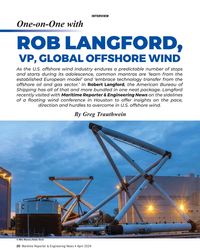 )
April 2024 - Maritime Reporter and Engineering News page: 20
)
April 2024 - Maritime Reporter and Engineering News page: 20starts during its adolescence, common mantras are ‘learn from the established European model’ and ‘embrace technology transfer from the offshore oil and gas sector.’ In Robert Langford, the American Bureau of Shipping has all of that and more bundled in one neat package. Langford recently visited with
-
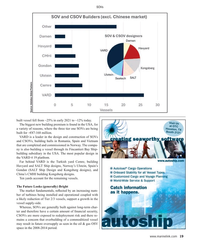 )
April 2024 - Maritime Reporter and Engineering News page: 19
)
April 2024 - Maritime Reporter and Engineering News page: 19exposed to redeployment risk and there re- mains a concern that overbuilding of a commoditized vessel may result in future oversupply as seen in the oil & gas OSV space in the 2008-2014 period. www.marinelink.com 19 MR #4 (18-33).indd 19 4/5/2024 8:13:37 A
-
 )
April 2024 - Maritime Reporter and Engineering News page: 18
)
April 2024 - Maritime Reporter and Engineering News page: 18MARKETS & gas activity returns, we anticipate that supply of the vessels The Question of Emissions to offshore wind projects will reduce, driving demand for ad- Given that SOVs and CSOVs operate in a segment target- ditional CSOVs. ing reduced emissions, and many operate in the North Eu- Outside of China
-
 )
April 2024 - Maritime Reporter and Engineering News page: 16
)
April 2024 - Maritime Reporter and Engineering News page: 16to a wind turbine OEM or offshore wind in-built crane and gangway. farm operator to service and maintain equipment dur- ¦Tier 2: Generally, oil & gas tonnage (MPSVs, PSVs, ing the operations period of the wind farm. A typical etc.) with ? xed gangway, serving oil & gas and SOV will accommodate
-
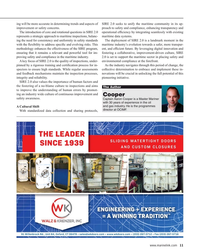 )
April 2024 - Maritime Reporter and Engineering News page: 11
)
April 2024 - Maritime Reporter and Engineering News page: 11culture of continuous improvement and Cooper safety awareness. Captain Aaron Cooper is a Master Mariner with 30 years of experience in the oil and gas industry. He is the programmes A Cultural Shift director at OCIMF. With standardized data collection and sharing protocols, THE LEADER SLIDING
-
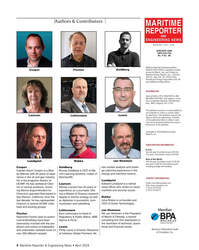 )
April 2024 - Maritime Reporter and Engineering News page: 4
)
April 2024 - Maritime Reporter and Engineering News page: 4Ma- gic planning experience in the ter Mariner with 30 years of expe- rine Learning Systems, maker of energy and maritime sectors. rience in the oil and gas industry. MarineLMS. CONTACT INFORMATION: He is the programs director at Lundquist Email: [email protected] OCIMF. He has worked at Chev- Laursen
-
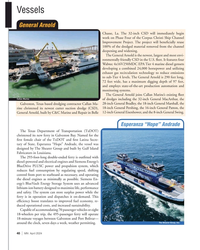 )
April 2024 - Marine News page: 40
)
April 2024 - Marine News page: 40in the U.S. ? eet. It features four Wabtec 4x16V250MDC EPA Tier 4 marine diesel gensets developing a combined 24,000 horsepower and utilizing exhaust gas recirculation technology to reduce emissions to sub-Tier 4 levels. The General Arnold is 290 feet long, 72 feet wide, has a maximum digging depth
-
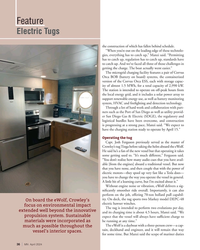 )
April 2024 - Marine News page: 36
)
April 2024 - Marine News page: 36and detection technology. Through a lot of hard work and collaboration with part- ners such as the Port of San Diego as well as utility provid- er San Diego Gas & Electric (SDGE), the regulatory and logistical hurdles have been overcome, and construction is progressing at a strong pace, Manzi said. “We expect
-
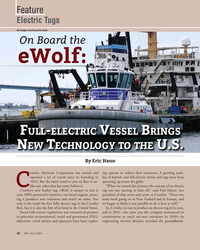 )
April 2024 - Marine News page: 32
)
April 2024 - Marine News page: 32Feature Electric Tugs All images courtesy Eric Haun On Board the eWolf: F - V B ULL ELECTRIC ESSEL RINGS EW ECHNOLOGY TO THE N T U.S. By Eric Haun rowley Maritime Corporation has owned and ing options to reduce their emissions. A growing num- operated a lot of vessels since its founding in ber
-
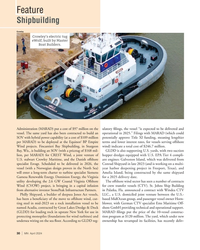 )
April 2024 - Marine News page: 30
)
April 2024 - Marine News page: 30Feature Shipbuilding Crowley Crowley’s electric tug eWolf, built by Master Boat Builders. Administration (MARAD) put a cost of $97 million on the ulatory ? lings, the vessel “is expected to be delivered and vessel. The same yard has also been contracted to build an operational in 2025.” Filings with
